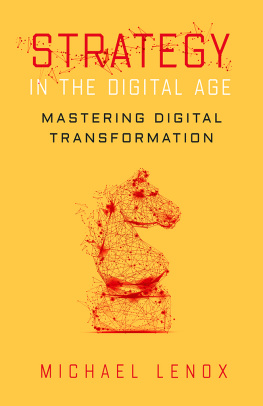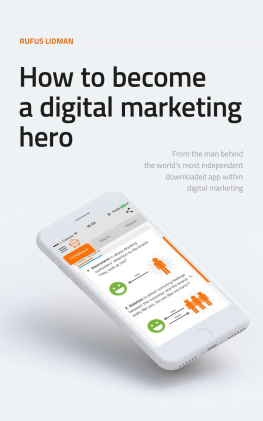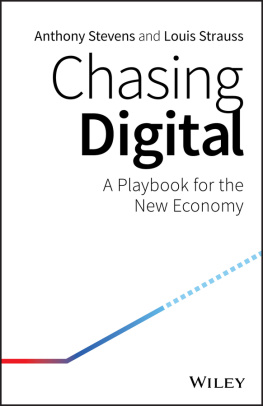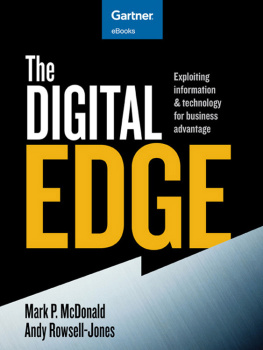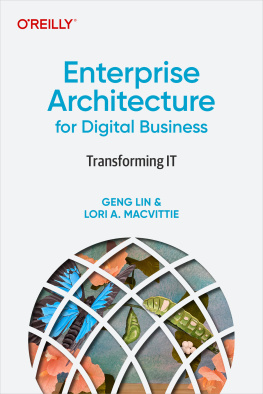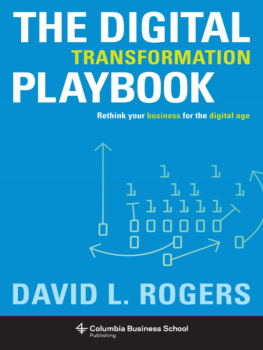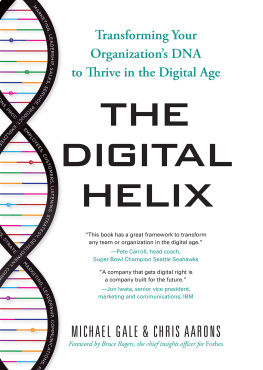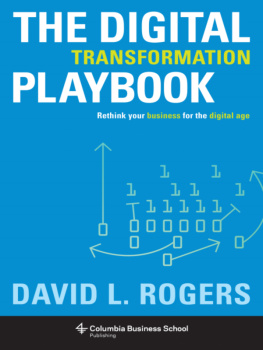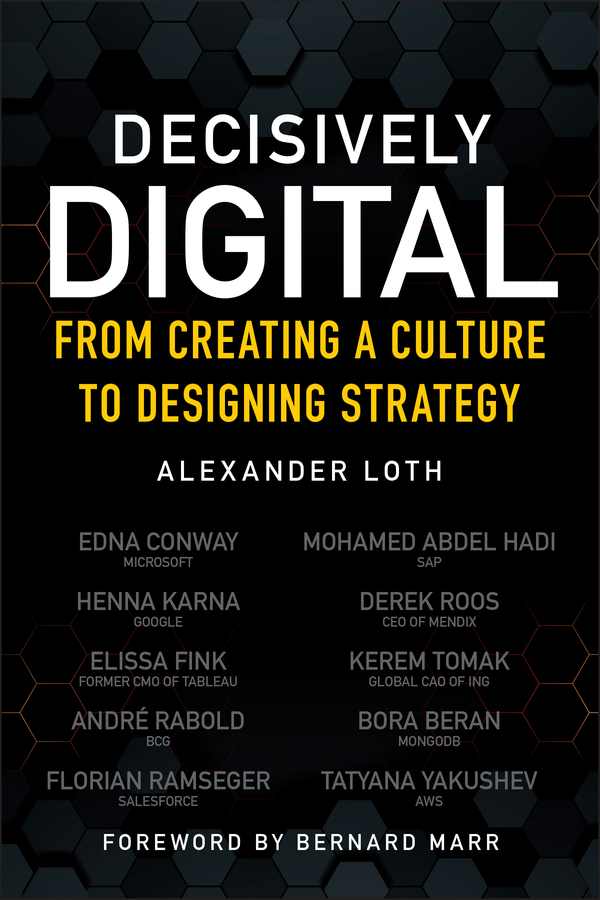
Table of Contents
List of Tables
- Chapter 21
List of Illustrations
- Chapter 1
- Chapter 5
- Chapter 6
- Chapter 12
- Chapter 13
- Chapter 16
- Chapter 17
- Chapter 19
- Chapter 21
- Chapter 27
Guide
Pages
Decisively Digital
From Creating a Culture to Designing Strategy
Alexander Loth

Copyright 2021 by John Wiley & Sons, Inc. All rights reserved.
Published by John Wiley & Sons, Inc., Hoboken, New Jersey.Published simultaneously in Canada.
No part of this publication may be reproduced, stored in a retrieval system or transmitted in any form or by any means, electronic, mechanical, photocopying, recording, scanning or otherwise, except as permitted under Sections 107 or 108 of the 1976 United States Copyright Act, without either the prior written permission of the Publisher, or authorization through payment of the appropriate per-copy fee to the Copyright Clearance Center, 222 Rosewood Drive, Danvers, MA 01923, (978) 750-8400, fax (978) 646-8600. Requests to the Publisher for permission should be addressed to the Permissions Department, John Wiley & Sons, Inc., 111 River Street, Hoboken, NJ 07030, (201) 748-6011, fax (201) 748-6008, or online at www.wiley.com/go/permissions.
Limit of Liability/Disclaimer of Warranty: While the publisher and author have used their best efforts in preparing this book, they make no representations or warranties with respect to the accuracy or completeness of the contents of this book and specifically disclaim any implied warranties of merchantability or fitness for a particular purpose. No warranty may be created or extended by sales representatives or written sales materials. The advice and strategies contained herein may not be suitable for your situation. You should consult with a professional where appropriate. Neither the publisher nor author shall be liable for any loss of profit or any other commercial damages, including but not limited to special, incidental, consequential, or other damages.
For general information on our other products and services please contact our Customer Care Department within the United States at (877) 762-2974, outside the United States at (317) 572-3993 or fax (317) 572-4002.
Wiley also publishes its books in a variety of electronic formats. Some content that appears in print may not be available in electronic formats. For more information about Wiley products, visit our web site at www.wiley.com.
Library of Congress Control Number: 2021936782
ISBN: 978-1-119-73728-5
ISBN: 978-1-119-73748-3 (ebk)
ISBN: 978-1-119-73729-2 (ebk)
Trademarks: WILEY and the Wiley logo are trademarks or registered trademarks of John Wiley & Sons, Inc. and/or its affiliates, in the United States and other countries, and may not be used without written permission. All other trademarks are the property of their respective owners. John Wiley & Sons, Inc. is not associated with any product or vendor mentioned in this book.
For Yue and Noah. And for my parents.
About the Author
Alexander Loth is a digital strategist with a background in computational nuclear research. For more than 12 years he has advised many large companies in their transformations as they become digital organizations. Since 2019 he has been with Microsoft as executive advisor.
Alexander has an MBA from the Frankfurt School of Finance & Management, where he is also a lecturer on the subject of the digital society. Prior to working for Microsoft, he worked for Tableau (now part of Salesforce), for Capgemini, for SAP, and at the European Organization for Nuclear Research (CERN).
Furthermore, Alexander studied at the China Europe International Business School (CEIBS) in Shanghai and was a postgraduate researcher at the University of the West of England's Department of Computer Science. His research focused on machine-learning algorithms for geodistributed petabyte-scale big-data processing.
A cofounder of fintech advisory Futura Analytics, Alexander has written and spoken extensively on topics such as digital transformation, artificial intelligence, blockchain, and business analytics. Alexander is the author of the book Visual Analytics with Tableau.
Acknowledgments
I would like to thank the many people who helped make this book a reality. They provided critical feedback on initial drafts, extremely useful input during many conversations, and general guidance throughout the whole project. They include the people at Wiley and my colleagues at Microsoft. I would like to specifically mention the following people:
Vladimir Alexeev, Bora Beran, Marcel Bickert, Sofie Blakstad, Sarah Burnett, Ian Choo, Edna Conway, Darren Cooper, Sophia Cullen, Achim Dettweiler, Sebastian Durnwalder, Martin Duschek, Duncan Elliott, Lee Feinberg, Elissa Fink, Pete Gaughan, Patrick Glauner, Mohamed Abdel Hadi, Henna A. Karna, Patrick Kirchgner, Daniel Kompe, Andreas Kopp, Kerstin Krmer, Mark Kromer, Barath Kumar Rajasekaran, Jens Lamparth, Celeste Luna, Christy Marble, Yilian Villanueva Martinez, Jim Minatel, Jordan Morrow, Ben Niu, Nico Peters, Andr Rabold, Florian Ramseger, Derek Roos, Philipp Sandner, Sven Sommerfeld, Kerem Tomak, Cameron Turner, Patrick Walsh, Louise Watson, Kim Wimpsett, Tatyana Yakushev, Qiang Yang, and Yue Zhou-Loth.
I especially thank my family for their patience and encouragement.
Thank you very much!
Alexander Loth
Foreword by Bernard Marr
We are amidst a fourth industrial revolution that, like the previous three industrial revolutions, will transform many key aspects of business and society. While the previous industrial revolutions were driven by single technological shifts (steam power, electricity, and computers), over recent years, we have seen amazing advances in technologies such as artificial intelligence, big data analytics, cloud computing, virtual and augmented reality, the internet of things (IoT), 5G mobile networks, blockchains, intelligent robots, 3D printing, gene editing, and synthetic biology. Each of these trends could have triggered a new industrial revolution on its own, however, the simultaneous emergence of these technologies creates a perfect storm of unprecedented technology-driven innovation and transformation. The main consequence is that every single business, in every industry, has to become a technology business and a digital business. Any business that doesn't put technology and digitization at the center of their business strategy will simply be left behind.
The global coronavirus pandemic has only accelerated this transformation, as more business processes and customer interfaces needed to be digitized to enable organizations to carry on operating. It forced many organizations, even those that would not have focused on digital transformation, to prioritize it as a factor of survival. Over the past 12 months we have seen digital transformations that would have taken many years to complete under normal circumstances. As traditional channels to market got cut off as countries went into lockdown and as people required digital cloud-based working environments to carry on working from home, digital transformation was fast tracked. Today, we live in a digital-first environment that will never go back to what it was prior to the pandemic.
Next page

